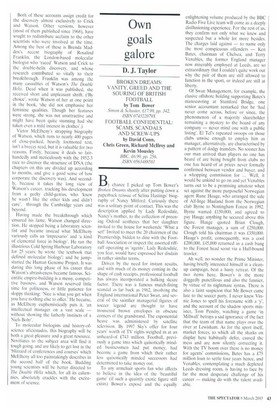Eureka proclaimed too loudly
Robert Macfarlane
WATSON AND DNA: MAKING A SCIENTIFIC REVOLUTION by Victor K. McElheny Wiley, £18.99, pp. 365, ISBN 0470854294 James Watson has all the makings of a great biographical subject. He is notoriously volatile, splenetic, and aggressive. During his career he has not fought shy of public controversy. And of course he is globally famous for a single achievement: having been one of the two men who, in 1953, 'discovered' the double-helix structure of DNA. The discovery was, as one peer put it, 'a scientist's dream: simple, elegant, and universal for all organisms'. It brought the pathologically ambitious Watson a Nobel Prize at the age of 34, and 'triggered and sustained a revolution in science that affects us all'.
The story of how that discovery occurred, like that of most scientific epiphanies, exists in several forms. It has, as a chemist might put it. multiple allotropes. There is the wipe-clean Eureka legend that has Watson and Crick swilling bitter in the Eagle pub in Cambridge, and scribbling the double helix on the back of a beer-mat during 30 minutes of visionary brilliance. Then there is the story told in Watson's million-selling 1968 book, The Double Helix — which Victor McElheny calls 'the most indiscreet memoir in the history of science' — where Watson paints himself as a 'brat-genius', and Crick as his immodest mentor and partner-in-ego.
Both of these accounts assign credit for the discovery almost exclusively to Crick and Watson. Other versions, however (most of them published since 1968), have sought to redistribute acclaim to the other scientists who were involved at the time. Among the best of these is Brenda Maddox's recent biography of Rosalind Franklin. the London-based molecular biologist who 'raced' Watson and Crick to the double-helix discovery, and whose research contributed so vitally to their breakthrough. Franklin was among the many casualties of Watson's The Double Helix. Dead when it was published, she received short and unpleasant shrift. (`By choice', wrote Watson of her at one point in the book, `she did not emphasise her feminine qualities. Though her features were strong, she was not unattractive and might have been quite stunning had she taken even a mild interest in clothes'.)
Victor McElheny's strapping biography of Watson. which runs to nearly 400 pages of close-packed, heavily footnoted text, isn't a breezy read, but it is valuable for two reasons. Firstly, because it deals so fairhandedly and meticulously with the 1952-3 race to discover the structure of DNA (the chapters on this are divided up according to months, and give a good sense of how corporate the discovery was). And secondly, because it takes the long view of Watson's career, tracking his development from a geek-y child-genius, who `knew he wasn't like the other kids and didn't care', through the Cambridge years and beyond.
Having made the breakthrough which ensured his fame, Watson changed direction, He stopped being a laboratory scientist and became instead what McElheny variously calls an 'impresario' and `a kind of elemental force in biology'. He ran the illustrious Cold Spring Harbour Laboratory for 25 years; he wrote `the textbook that defined molecular biology'; and he jumpstarted the Human Genome Project. It was during this long phase of his career that Watson's abrasiveness became famous. Scientific empire-building is a messy, competitive business. and Watson reserved little time for politeness, or little patience for sloppy thinking: Nice is what you get when you have nothing else to offer.' He became, as McElheny euphemistically puts it, 'an intellectual manager on a vast scale — without showing the fatherly instincts of a Niels Bohr'.
To molecular biologists and history-ofscience aficionados, this biography will be both a great pleasure and a great resource. Novitiates to the subject area will find it tough going. and are likely to get lost in the 'blizzard of conferences and courses' which McElheny all too painstakingly describes in the second half of the book. Budding young scientists will be better directed to The Double Helix which, for all its calumnies, absolutely crackles with the excitement of science.



































































 Previous page
Previous page